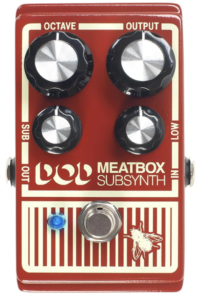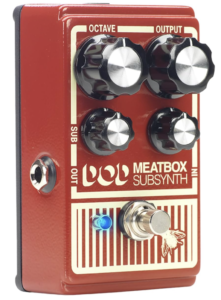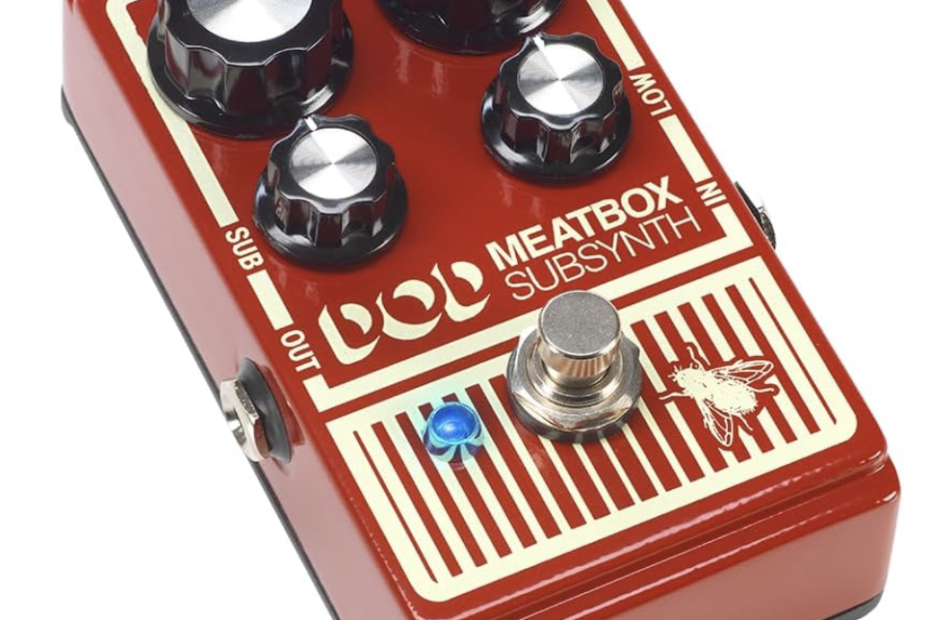The DigiTech DOD Meatbox is a bass subharmonic synthesizer and effects pedal that is designed to add powerful and deep low-frequency tones to your bass guitar or other audio sources.
The Meatbox is known for its ability to produce extremely low frequencies and create a massive sub-bass presence, making it a favorite among bass players looking to add extra weight and depth to their sound.
Subharmonic Synthesis
 The primary function of the Digitech DOD Meatbox [buy here] is to synthesize subharmonic frequencies, which are frequencies that are one octave or more below the fundamental tone. This adds a rich and powerful low-end to your sound that can be felt as much as heard.
The primary function of the Digitech DOD Meatbox [buy here] is to synthesize subharmonic frequencies, which are frequencies that are one octave or more below the fundamental tone. This adds a rich and powerful low-end to your sound that can be felt as much as heard.
Subharmonic synthesis is a unique and powerful audio processing technique that involves generating frequencies that are one or more octaves below the fundamental tones of the original audio source. In the context of the DOD Meatbox pedal, subharmonic synthesis is the core feature that allows the pedal to create deep, resonant, and impactful sub-bass frequencies. Here’s how subharmonic synthesis works and how it is implemented in the DOD Meatbox:
The pedal generates subharmonic frequencies by creating new tones that are mathematically related to the original audio source. For example, if the fundamental frequency of the input signal is 50 Hz, the pedal might generate subharmonics at 25 Hz (one octave below), 12.5 Hz (two octaves below), and so on.
Subharmonic synthesis effectively creates an “octave down” effect by adding lower octaves of the original signal. This is particularly useful for bass players who want to add a powerful and extended low-end presence to their sound.
Also Read:
Donner Arena 2000 Multi Effects Pedal
Source Audio C4 Synth Pedal Review
MOOER Acoustikar Acoustic Guitar Simulator Pedal
LEKATO Multi Effects Guitar Pedal
MOOER Micro Drummer II Pedal Review
Tonal Enrichment
 Subharmonic synthesis can significantly enrich the tonal palette of an audio signal. It adds depth, weight, and fullness to the sound, making it especially effective for bass instruments.
Subharmonic synthesis can significantly enrich the tonal palette of an audio signal. It adds depth, weight, and fullness to the sound, making it especially effective for bass instruments.
The subharmonics generated by the pedal are related to the harmonic series of the original audio source. The harmonic series is a sequence of frequencies that are integer multiples of the fundamental frequency. Subharmonics add new tones to this series, extending it into the sub-bass range.
Many subharmonic synthesis pedals, including the DOD Meatbox, feature a “blend” control. This control lets you adjust the balance between the generated subharmonics and the original dry signal. By blending the two signals, you can control the intensity and presence of the sub-bass effect.
Low Pass Filter
Some subharmonic synthesis pedals may include a low pass filter. This filter allows you to shape the frequency content of the subharmonic tones, making them sound warmer, smoother, or more focused.
Expression Pedal Control: In some pedals, including the DOD Meatbox [buy here], you may have the option to control the blend or other parameters using an expression pedal. This provides real-time control over the depth of the subharmonic effect.
Subharmonic synthesis is a creative tool that can be used to add depth and impact to various types of audio sources, particularly bass instruments. It’s important to use subharmonics in moderation, as extreme settings can result in a “muddy” or overly resonant sound. Experimenting with different blend settings and adjusting the pedal’s parameters can help you achieve the desired sub-bass effect while maintaining clarity and balance in your overall sound.
Octave Down Effect
 The Meatbox generates an octave-down effect that adds a deep and rumbling sub-bass tone to your signal. This can help your bass lines cut through the mix and create a more immersive sonic experience.
The Meatbox generates an octave-down effect that adds a deep and rumbling sub-bass tone to your signal. This can help your bass lines cut through the mix and create a more immersive sonic experience.
The “Octave Down Effect” on the DOD Meatbox refers to the pedal’s ability to generate a new audio signal that is one octave lower than the original input signal. This effect is a fundamental aspect of subharmonic synthesis, which is a technique used to create deep and powerful low-frequency tones.
When you engage the Octave Down Effect on the DOD Meatbox, the pedal takes the incoming audio signal from your bass guitar (or other source) and generates a new signal that is pitched down by one octave. This means that the frequencies of the new signal will be half the frequency of the original signal. For example, if you play a note with a fundamental frequency of 100 Hz, the Octave Down Effect will generate a new note at 50 Hz.
Key points about the Octave Down Effect on the DOD Meatbox:
- Deep Bass Enhancement: The Octave Down Effect produces a sub-bass frequency that adds a deep, rumbling, and resonant low end to your sound. This can be especially impactful for bass players who want to create a massive and weighty presence in their playing.
- Thickening the Sound: Engaging the Octave Down Effect can thicken your overall tone and create a fuller sound. The lower octave complements the original notes, adding an extra layer of depth to your bass lines.
Blend Control
Many subharmonic synthesis pedals, including the DOD Meatbox [buy here], provide a blend control. This control allows you to mix the generated octave-down signal with the dry (original) signal. By adjusting the blend, you can control the balance between the two signals and achieve the desired level of sub-bass enhancement.
The “Blend” control on the DOD Meatbox (and many other audio effects pedals) allows you to adjust the balance between the processed (effected) signal and the dry (unprocessed) signal. This feature provides you with precise control over how much of the effect’s sound is mixed with the original input signal. In the context of the DOD Meatbox, the Blend control affects the balance between the subharmonic synthesizer’s generated sub-bass tones and the original dry signal from your bass guitar or other audio source.
Here’s how the Blend control works and its significance:
- 100% Dry (Original Signal): When the Blend control is set fully counterclockwise (usually labeled as “Dry” or “Original”), only the unprocessed original signal from your bass guitar is heard. In this mode, the subharmonic synthesis effect is completely bypassed, and you’ll hear your bass as you would without any added sub-bass.
- 100% Wet (Processed Signal): When the Blend control is set fully clockwise (usually labeled as “Wet” or “Processed”), you hear only the generated subharmonic tones from the DOD Meatbox, and the original signal is completely replaced. This can result in a heavily processed, sub-bass-rich sound.
- Blended Sound: The most common use of the Blend control is to set it somewhere between 0% and 100%. In this range, you get a mix of both the original dry signal and the generated subharmonic tones. By adjusting the Blend control, you can dial in the perfect amount of sub-bass effect to suit your musical needs.
Practical Applications
- Subtle Enhancement: Setting the Blend control to a lower percentage (e.g., around 25% or 50%) allows you to add a subtle layer of sub-bass to your sound. This can thicken your bass lines and create a fuller sound without overpowering the original tone.
- Massive Sub-Bass: Setting the Blend control closer to 100% emphasizes the subharmonic effect, creating a massive and powerful sub-bass presence that can be especially effective for certain musical genres or specific sections of a song.
- Tonal Balance: Adjusting the Blend control helps you achieve the desired tonal balance between the dry and processed signals. You can tailor the sub-bass effect to complement the rest of your mix and instruments.
- Low Pass Filter: The pedal may include a low pass filter to shape the tonal characteristics of the octave-down signal. Adjusting the filter can affect the overall warmth and clarity of the sub-bass frequencies.
- Creative Possibilities: The Octave Down Effect opens up creative possibilities for bass players who want to experiment with different textures and sonic landscapes. It can be used to create dramatic drops in pitch, simulate the sound of a synthesizer, or simply add a massive low-end punch to your playing.
Other Features
- Sub and Low Controls: The pedal often features dedicated controls for adjusting the levels of the subharmonic frequencies and the original low frequencies, giving you precise control over the tonal balance.
- Sturdy Construction: The Meatbox is typically built in a durable and rugged enclosure, making it suitable for live performances and studio use.
- Expression Pedal Input: Some versions of the Meatbox may have an expression pedal input, allowing you to control parameters such as blend or filter frequency in real-time using an expression pedal.
- Unique Tonal Character: The Meatbox [buy here] is revered for its ability to create a distinctive and massive low-end character, making it a favorite for bass players who want to stand out and make a bold sonic statement.
